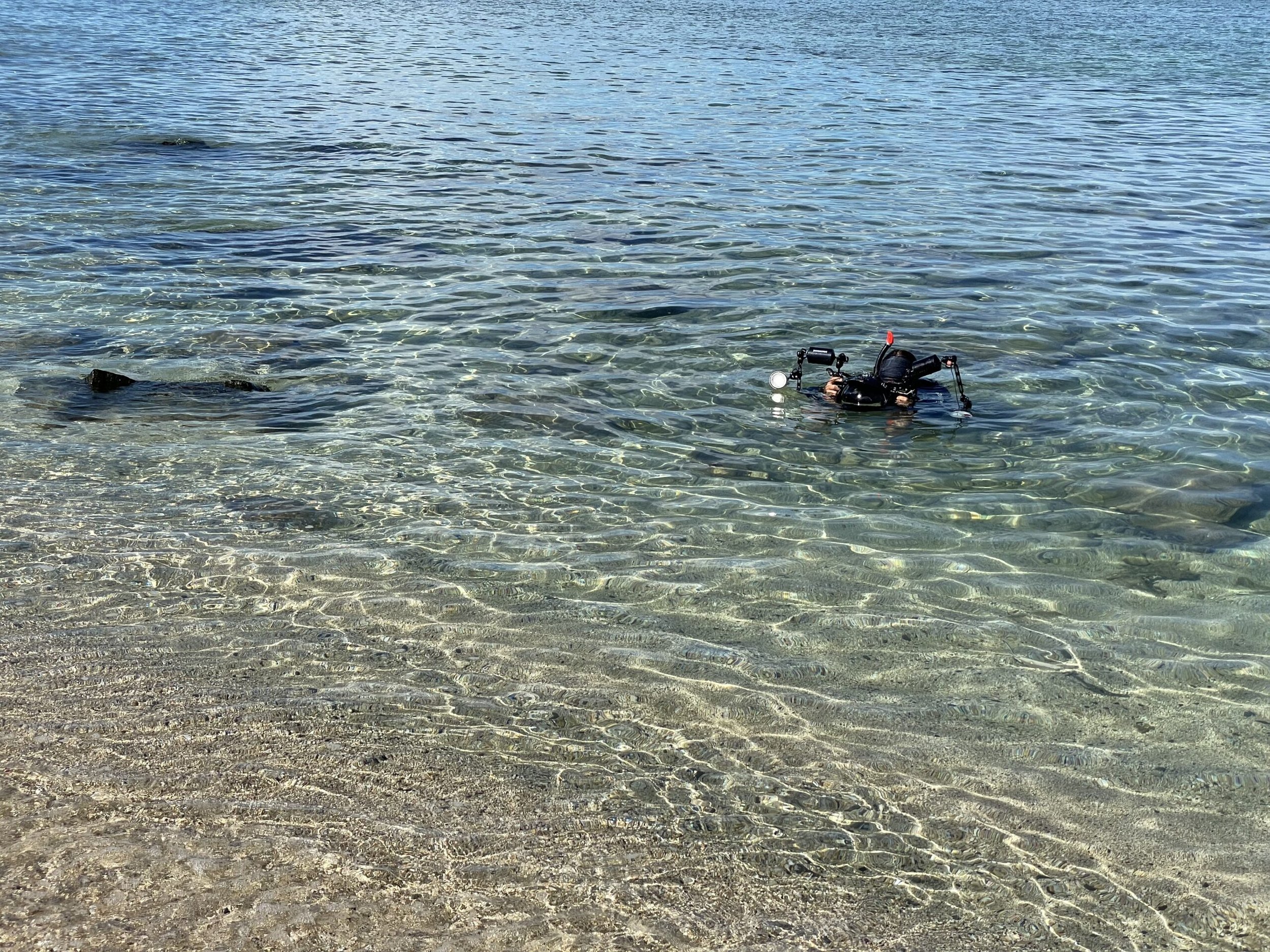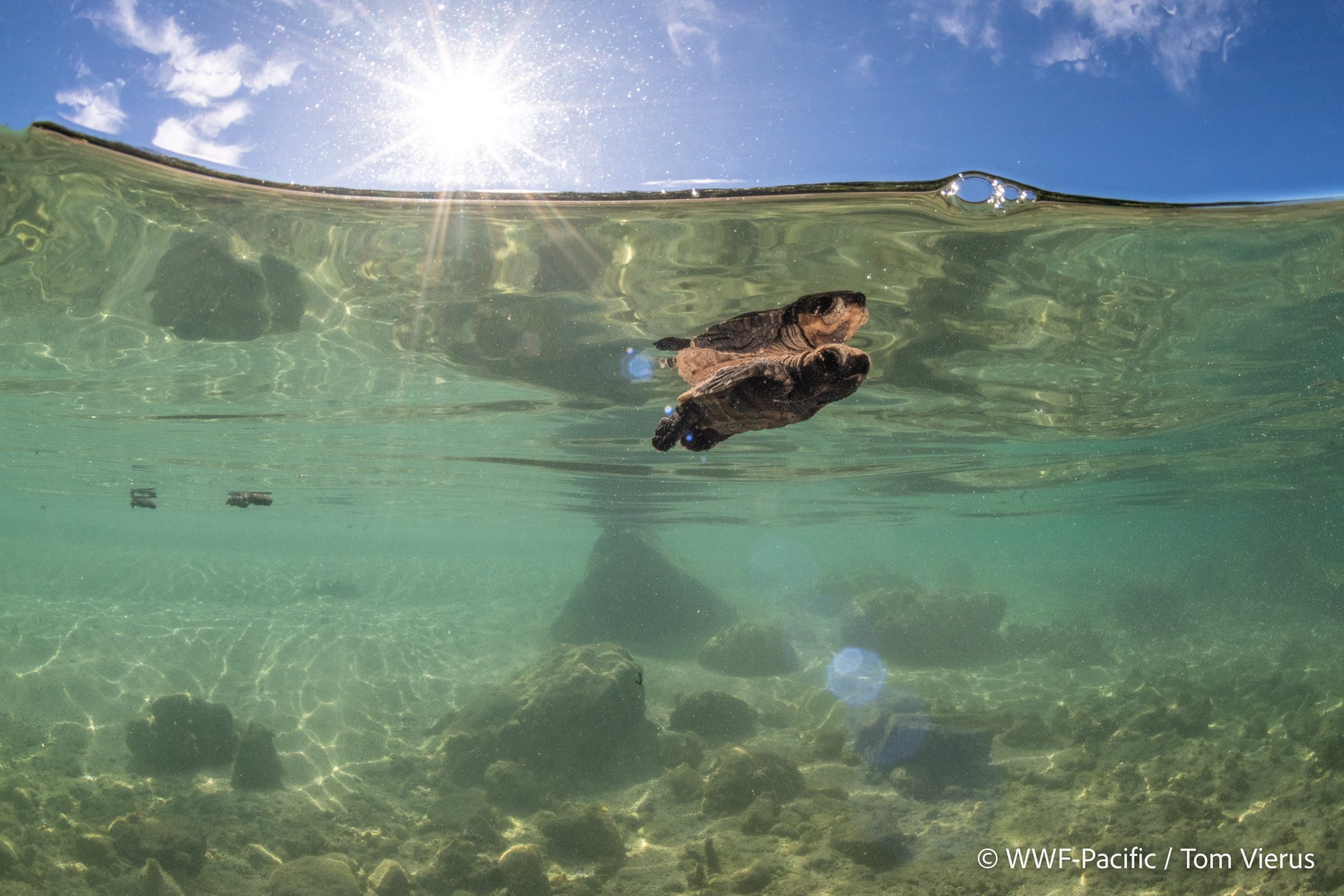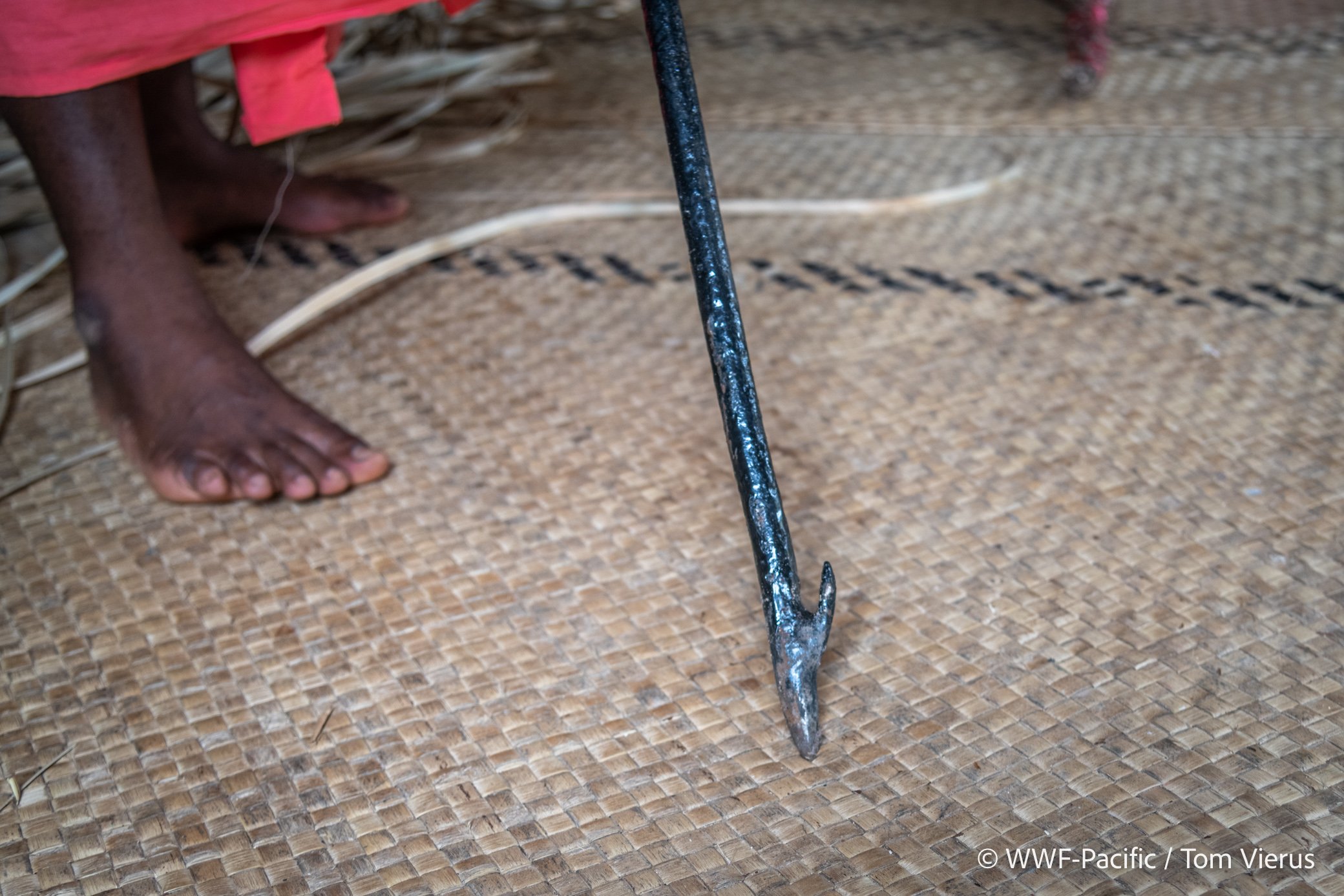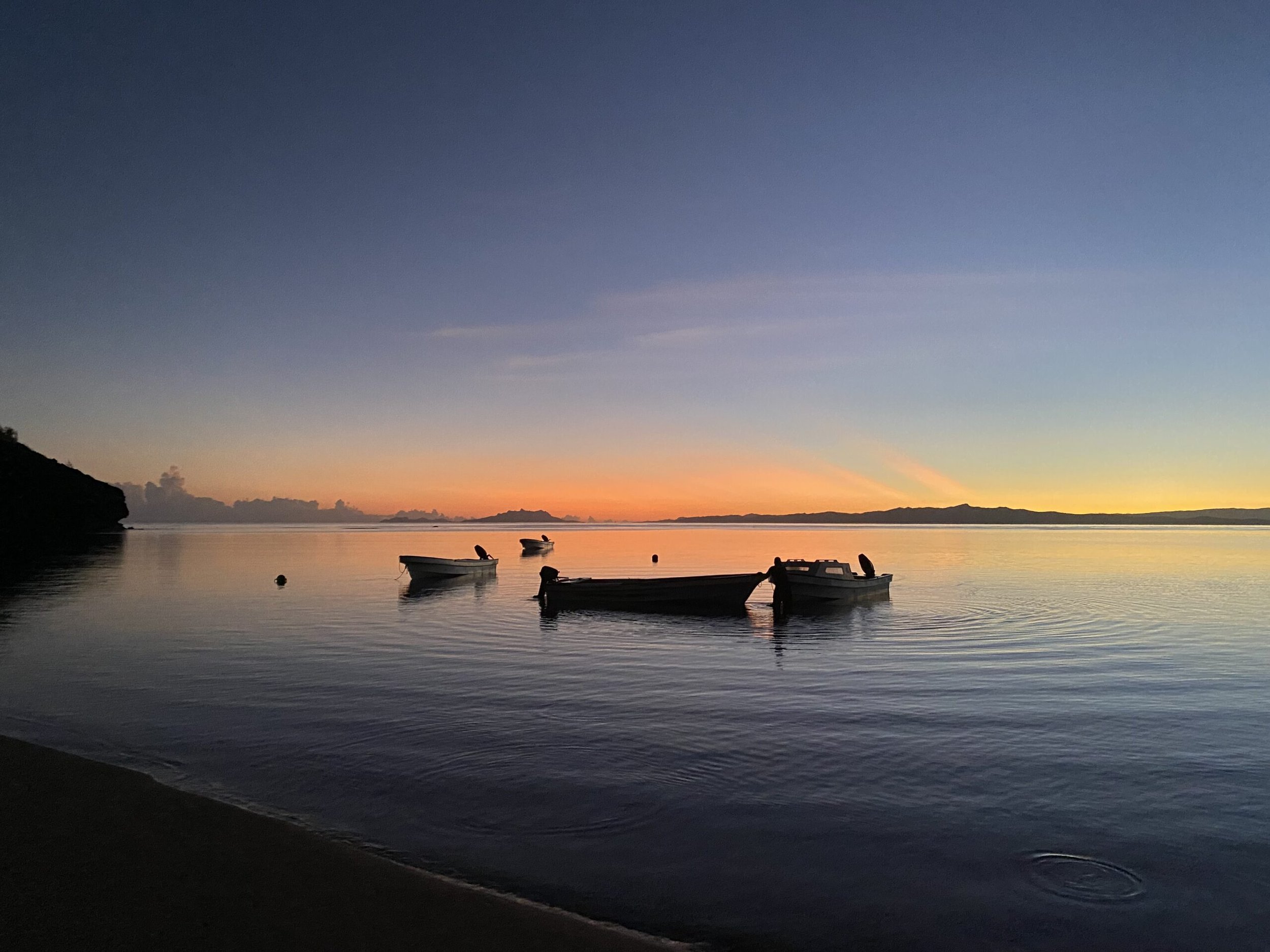WWF Turtle Monitoring on Yadua Taba Island in Fiji
After we had returned from Kavewa Island and spent a night at the WWF headquarters in Labasa, our next destination was Yadua Island to the west of Vanua Levu, Fiji's second largest island. More specifically, we planned to camp one night on the neighbouring Yadua Taba Island, an uninhabited nature reserve with several beaches serving as turtle nesting sites.
The trip to Yadua Taba Island
Short sandwich break while we waited for Pita. Photo by Ravai Vafa’ou.
Two WWF turtle monitor volunteer patrol Cakalevu beach on Yadua Taba, a known turtle nesting site located east of Vanua Levu, Fiji.
Getting the gear ready under our weather protection. Photo by Ravai Vafo’ou.
From Labasa, we drove for about two hours towards a little landing site at Bua Bay. We met Pita Qarau, who, similarly to Emosi in Kavewa, was one of Fiji's first trained turtle monitors and is still actively working towards protecting turtles around his island. As he approached by boat, I realised I had already met Pita a few years back during the WWF Great Sea Reef Expedition, which I had documented for the World Wildlife Fund. Small world! From here, it was another 1.5-hour boat ride to Denimanu, Pita's village on Yadua Island. We met the three WWF volunteers and started preparing our equipment and supplies for a night camping on Yadua Taba. We were hoping to document a female turtle laying her eggs during the night, and logistically, it was the easiest to stay at one of the beaches overnight and patrol every 30 minutes to check for any turtle activity.
Setting up camp on Yadua Taba Island
The WWF turtle monitor volunteers led by senior tutle monitor Pita Qarau (left) check a known turtle nest on Cakalevu beach.
A ‘No Entry’ sign is located on Cakalevu Beach on Yadua Taba Island. This island, located east of Fiji’s second-largest island Vanua Levu, is a known turtle nesting site and a protected island that can only be visited with a special permit.
Portrait of the critically endangered Fiji Crested Iguana (Brachylophus vitiensis). This photo was taken on Yadua Taba Island, a National Trust of Fiji reserve and the last stronghold of this endemic species. Fiji Islands, South Pacific.
Ravai, Pita and Illiyaki had quickly set up a tarp which would function as our tent for the night while Pita's wife and the other volunteers put up their two tents and organised the cooking equipment. Once that was done, the team started their first patrol on the beach, looking for any new nests and checking the ones they knew of already. So far, no known nests had hatched. Later in the afternoon, I found some time to look for the Fiji Crested Iguana (Brachylophus vitiensis), an endemic species which is classified as 'Critically Endangered' by the International Union for Conservation of Nature. Here in the forests on Yadua Taba is their last stronghold in Fiji, and specifically for this reason, it was declared a protected area.
Without prior consent, no one is allowed to set foot on the island, and past initiatives have eradicated goats, mongoose and rats on the islöand to safeguard the Iguana population. What a privilege to be camping here! The island is 0.7 km2 in size and possesses one of the last dry forest areas in Fiji, a unique habitat that these iguanas prefer. It was declared a sanctuary by the National Trust of Fiji in 1980, and today, it harbours more than 90% of the entire Crested Iguana population worldwide. As the sun started setting, we all got ready for the darkness of night with solar lamps and head torches. I also made sure to have my gear in a dry space and in an easy-to-access position. I was planning to shoot some long exposure images later in the dark and, hopefully, a turtle laying her eggs.
Beach walks at night
Aerial view of Yadua island east of Vanua Levu, Fiji’s second-largest island.
Portrait of the WWF turtle monitor team taken at night during beach patrols on Yadua Taba Island, east of Vanua Levu, Fiji. From left to right: Ravaia Vafa’ou, Pita Qarau, Taravini Ranadi, Ateca Aditewa Cakaubora, Illiyaki Mounhi.
A team of WWF turtle monitor volunteers led by senior turtle monitor of Yadua Peta Qarau patrol Cakalevu beach on Yadua Taba at night. The team looks out for adult females that come to shore at night to dig their eggs and lay the eggs. To not disturb the adults with normal flashlights, the team uses red lights.
As soon as darkness fell, we started our half-hourly beach monitoring walks. The first few patrols we did all together and decided to later take turns, so everyone could catch a little sleep during the break. Always in teams of three or two, we would walk the entire length of the beach with a red light torch, hoping to catch a glimpse of a turtle arriving at the beach. The red light is important as it has the least impact on egg-laying turtles. On the other hand, white or "normal" light may confuse and disturb them, so it's best to avoid it altogether.
We spend the following hours lying on a tarp on the beach and admiring the spectacular sky full of stars while exchanging stories of all kinds. No cloud in the sky spoilt our five-star view here from this beautiful little uninhabited island in the South Pacific. While star gazing, all of us witnessed several shooting stars, and I told them about a German tradition I grew up with. When I was a child, I was told that when I saw a shooting star, I should close my eyes and make a wish. It is important, though, not to reveal the wish to anyone, or else it won't come true.
Whether we believed in it or not, I think most of us tried it out that night. I also used the chance of being on a deserted island at night and played around with some long-exposure techniques, trying to capture not only the stars in the sky but also the red light the volunteers were using during their patrols. The hours passed, and at some point past midnight, I fell asleep on the tarp right on the beach. Pita continued his walks throughout the night, but we weren't lucky this time. No female turtle would come to the beach to lay her eggs. That's the nature of wildlife assignments - it doesn't always work the way you want it to.
Hatchlings in the morning
In the water taking photos of the little turtle hatchlings. Photo by Ravai Vafo’ou.
A hawksbill turtle (Eretmochelys imbricata) hatchling makes its first swimming attempts in the shallow coastal waters around Yadua Taba Island, Fiji, where it hatched only minutes earlier. Hawksbill turtles are classified as ‘Critically Endangered’ by the International Union for Conservation of Nature (IUCN).
A hawksbill turtle (Eretmochelys imbricata) on its way to the Pacific Ocean after hatching on Yadua Taba Island, east of Vanua Levu, Fiji. Hawksbill turtles are classified as ‘Critically Endangered’ by the International Union for Conservation of Nature (IUCN).
The next morning, we rose with the sun and had another beautiful day ahead of us. A bit stiff from the night but instantly happy to be waking up where I was, the first thing to organise was a hot coffee. Pita's wife had already started to cook the water, and while everyone went about their morning routines, Pita spent the time already checking the nests again. A few minutes later, Pita shouted to us that one of the nests was in the process of hatching! Ravai and I grabbed my gear, and we made our way down the beach. This time, I planned to start taking images and videos from the hatching process before heading into the water and photographing the cuteness overload below the water's surface.
Similar to the first hatching nest near Kavewa Island, we witnessed a nest full of hatching eggs, and a little army of hawksbill turtles emerged; in total, the volunteers counted 131 individuals. Later that morning, we started wrapping up our campsite and waited for a boat taxi back to the village. On our way there, we planned to visit every beach frequently patrolled during the last month by Pita and the volunteers. We'd stop at the beaches, and while the team completed their patrol, I took aerial and ground photographs of the sites. This went on for about an hour and a half before we made our way back to Denimanu on Yadua.
One more night in the village before heading back to Viti Levu
Turtle monitor volunteers and senior turtle monitor of Yadua Peta Qarau discuss the plans for turtle monitoring on Yadua Taba, a small island north of Vanua Levu, Fiji.
Before the Fijian Ministry of Fisheries implemented a moratorium on sea turtles in 2010, most communities in Fiji hunted and consumed them. One way to kill them was by using a heavy metal-darted spear like this one. Vanua Levu, Fiji.
What a beautiful morning on Yadua Taba.
The rest of the day was spent with various activities: from shooting some more content of the turtle monitoring team in the village to doing the traditional 'thank-you-ceremony' with the volunteers at the chief's house, to pounding kava, swimming in the ocean, relaxing and finally packing for a very early morning start the next day. We planned to leave the village at 5 am. Usually, the mornings have the calmest water conditions, and the approximately one-hour fibreglass boat ride would be thus the fastest and most conformable.
The sun's rays were passing through the mangrove branches and leavfs as we turned into a small river back on Vanua Levu around 6 am. Water vapour rose from the river, and the entire scene was so beautiful it was almost surreal. We slowly cruised through the mangrove-fringed river, following all its twists and turns until we arrived at the jetty where our journey started two days ago. We transferred all the gear and logistical supplies into his pick-up van, tried finding space for all the people (Ravai, Pita, the three volunteers, the driver and myself) and headed back to Labasa. The next stop was Suva for two nights' rest before Ravai, and I would embark on the third and last part of the assignment: Dravuni Island in Kadavu. More to come in the next part of this series.
Have you subscribed to my newsletter yet? I am sending out 1-2 emails monthly to share some behind-the-scenes stories and photos of my projects and assignments here in the Pacific.















